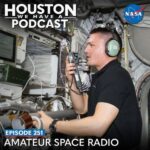ISS & LEO Satellites
ISS Direct RX 145.800 TX 144.490 PL67
ARISS/SSTV 145.800
IORS Default mode is for cross band repeater (145.990 MHz up {PL 67} & 437.800 MHz down).
ISS APRS (ISS) on 145.825 MHz FM
AO-91 with an uplink on 435.250 MHz (67.0 Hz CTCSS) downlink on 145.960 MHz. Mode: FM CTCSS 67.0Hz
AO-92
Uplink (MHz): 435.350 Downlink (MHz): 145.880 Mode: FM CTCSS 67.0Hz
AO-85 Currently active Tracking has been updated.
Uplink (MHz): 435.170 Downlink (MHz): 145.978 Mode: FM CTCSS 67.0Hz/200bps DUV/9k6 FSK
SO-50
145.850 MHz uplink and 436.795 MHz downlink. PL67 SO-50 also has a 10 minute timer that must be armed before use. Transmit a 2 second carrier with a PL tone of 74.4 to arm the timer, If not already Active.
Keep in mind, Some of these birds are having battery issues and may ONLY activate 2-4 minutes at a time, and dependant on the pass may not activate at all. Check the AMSAT Status pages.
There are a few others operating on USB/LSB/CW, and Beacons. I have not personally used them and cannot confirm if they work as I have not heard them when I tried. If you come across any new repeaters in Space that are viable, Please let us know.

NASA Interview with Courtney Black regarding ARISS
International Space Station Upgrades Amateur Radio Operations
ARISS, Amateur Radio on the International Space Station, announced that simultaneous operations of the ARISS voice repeater and digital APRS (Automatic Packet Reporting System) communications on the Space Station are now a reality.

NASA Astronaut Kjell Lindgren, KO5MOS, tweeted this photo of the ham radio station in the Columbus module, just before ARRL Field Day in June. https://tinyurl.com/2p9cr53f
|
Current ARISS operations include voice repeater transmissions with the JVC Kenwood TM-D710GA in the Columbus module and APRS operation from an identical radio in the Zvezda module. Packet operations are on 145.825 MHz.
The Columbus module radio uses the call sign NA1SS and the new radio in Zvezda uses RS0ISS. Aside from the call signs, the radios are identical, and packet operations are the same as before. You can use RS0ISS, ARISS, or APRSAT as the packet path. Both radios are expected to be running full time, except during educational contacts, extra vehicular activities (EVAs), and docking maneuvers. Final checkouts and equipment activation occurred on August 11.
ARISS International Chair Frank Bauer, KA3HDO, said, “Simultaneous operation of APRS and the voice repeater on ISS is transformative for ARISS. It represents a key element of our ARISS 2.0 initiative, providing interactive capabilities 24/7 that inspire, engage, and educate youth and lifelong learners — especially lifelong learning in ham radio operations. Our heartfelt thanks to Sergey Samburov, RV3DR, for making this crucial ARISS 2.0 initiative become a reality.”
Rosalie White, K1STO, one of two US delegates to ARISS, said the ham radio community will be very happy with the new radio operations from the ISS. “Hams really love doing ARISS packet, cross-band repeater, and Slow-Scan Television (SSTV) operations. Besides the thousands who download ARISS SSTV images downlinked from the ISS, we discovered that in a year’s time, hams did 80,000 ARISS packet messages,” she said. “We are not sure how many have been enjoying the ARISS cross band repeater, but we know it is a lot. This simultaneous operation capability is going to make many hams happy — and we know that keeping hams on the air is good for ARRL and good for amateur radio,” White added.
.jpg)
ARISS is a cooperative venture of international amateur radio societies and space agencies that support the ISS. In the US, sponsors are the Radio Amateur Satellite Corporation (AMSAT), ARRL The National Association for Amateur Radio®, and NASA’s Space Communications and Navigation (SCaN) program. The primary goal of ARISS is to promote exploration of science, technology, engineering, arts, and mathematics topics. ARISS does this by organizing scheduled contacts via amateur radio between crew members aboard the ISS and students. Before and during these radio contacts, students, educators, parents, and communities take part in hands-on learning activities tied to space, space technologies, and amateur radio. For more information, see www.ariss.org and www.arrl.org/amateur-radio-on-the-international-space-station.
LINKS


.jpg)